Exam (elaborations)
Financial accounting tests cerro coso community college
- Course
- BSAD101 (BSAD101)
- Institution
- Cerro Coso Community College
Financial accounting tests from cengage, taught by Professor Timbone at Cerro Coso Community College
[Show more]



